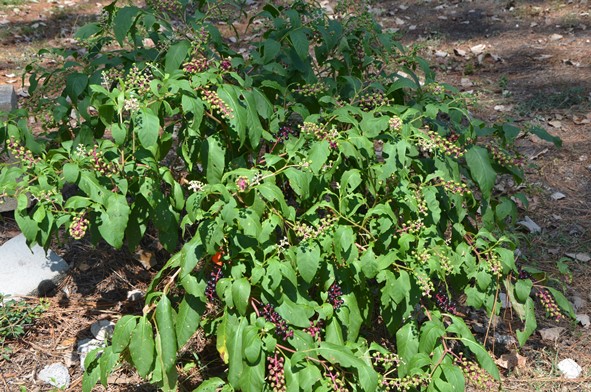Half a century ago the AM airwaves included a tune by a rock singer who crooned about Polk Salad Annie. While not exactly epic lyrics, it did have a catchy beat which made it to number eight on Billboard’s Hot 100.
The basis of this dish was common pokeweed (Phytolacca americana), a native of North American perennial weed frequently found in pastures as well as fence-rows, fields, wooded areas and neglected residential landscapes.
The reason this plant is only on the menu of the economically distress is all parts of it contain saponins, oxalates, and the alkaloid toxin phytolacine. The roots and seeds of this species contain the highest concentrations of these compounds.
As winter moves to spring, this plant is emerging from its winter dormancy. The warm summer of 2019 has accelerated the regrowth in north Florida and the surrounding states.
Once pokeweed becomes established, it regrows each year from a large, fleshy taproot which penetrates over a foot deep. The crown of the root is where the plant is regenerated and can be as large as five and a half inches in diameter at the soil surface within two growing seasons.
Pokeweed usually has a red trunk like stem, which becomes hollow as the plant matures later in the year. Leaves become quite large as the plant grows to its full potential and are the basis for the Polk salad.
The process for rendering the leave edible by humans, or other mammals, involves boiling and washing with a second boiling and more washing. Short of eminent starvation, it is not a good or safe meal choice for dining.
When in bloom the individual flowers appear green to white and are typically missing petals. Fruits are green when immature and turn a deep purple to black at maturity which is the basis for one alternate name for this species, inkberry.
Each fruit contains about nine small, hard-shelled seeds. Pokeweed can produce a few thousand seeds to over 48,000 seeds per plant annually.
In the right situation these seeds may remain viable in the soil for over four decades (40 years). When exposed to favorable environmental conditions the seed sprout and the process is repeated.
While not a suitable selection for people or livestock, birds eat the fruits without much evidence of harm and are usually the means for seed dispersal. Roosting sites along fence rows and under utility lines frequently show signs of seed deposits.
In addition to feeding cardinals, mocking birds, cedar waxwings and other avian species, the pokeweed is host to a variety of insects. Some are beneficial and others are not.
A number of caterpillars utilize this weed to sustain their larval stage of development. Unfortunately, some other less desirable insects use the local weed, too.
Pokeweed can act as reservoirs of various viruses transmitted by insects which are destructive to vegetable and ornamental plants. Whiteflies and aphids are the main culprits, but other insect species can contribute the disease issue.
Old rock tunes aside, it is best to leave the pokeweed and Polk salad to the bugs and birds.
To learn more about pokeweed read the UF/IFAS publication COMMON POKEWEED.
- Pokeweed: Adding Purple to the Fall Palet - September 27, 2019
- Wakulla Springs Offers The Biggest, And The Best, Natural Florida Experience - January 4, 2019
- Silent Night It Is Not!!! Cicadas Sing the Evening Away. - October 26, 2018

